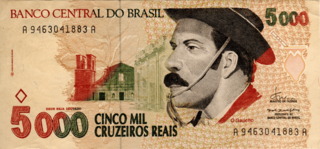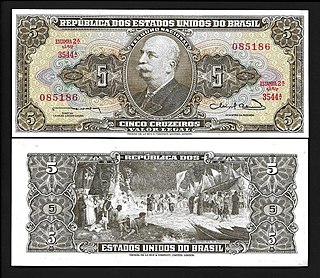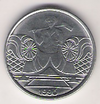The Mexican peso is the currency of Mexico. Modern peso and dollar currencies have a common origin in the 16th–19th century Spanish dollar, most continuing to use its sign, "$".

The Portuguese escudo was the currency of Portugal from 22 May 1911 until the introduction of the euro on 1 January 2002. The escudo was subdivided into 100 centavos. The word escudo derives from the scutum shield.
The peso is the currency of Argentina since 1992, identified within Argentina by the symbol $ preceding the amount in the same way as many countries using peso or dollar currencies. It is subdivided into 100 centavos, but due to rapid inflation, coins with a face value below one peso are now rarely used. Its ISO 4217 code is ARS. It replaced the austral at a rate of 10,000 australes to one peso.

The Colombian peso is the currency of Colombia. Its ISO 4217 code is COP. The official peso symbol is $, with Col$. also being used to distinguish it from other peso- and dollar-denominated currencies.
The kwanza is the currency of Angola. Four different currencies using the name kwanza have circulated since 1977. The currency derives its name from the Kwanza River.
The centavo is a fractional monetary unit that represents one hundredth of a basic monetary unit in many countries around the world. The term comes from Latin centum, with the added suffix -avo ('portion').
Brazilian cruzeiro refers to any of four distinct Brazilian currencies:

The cruzado was the currency of Brazil from 1986 to 1989. It replaced the second cruzeiro in 1986, at a rate of 1 cruzado = 1000 cruzeiros (novos) and was replaced in 1989 by the cruzado novo at a rate of 1000 cruzados = 1 cruzado novo.

The cruzeiro real was the short-lived currency of Brazil between August 1, 1993, and June 30, 1994. It was subdivided in 100 centavos; however, this subunit was used only for accounting purposes, and coins and banknotes worth 10 to 500 of the preceding cruzeiro remained valid and were used for the purpose of corresponding to centavos of the cruzeiro real, especially when the redenomination was carried out. The currency had the ISO 4217 code BRR.

Peso dominicano has been the name of the currency of the Dominican Republic since 2010. Its symbol is "$", with "RD$" used when distinction from other pesos is required; its ISO 4217 code is "DOP". Each peso is divided into 100 centavos ("cents"), for which the ¢ symbol is used. With exception of the United States dollar, it is the only currency that is legal tender in the Dominican Republic for all monetary transactions, whether public or private.
The metical is the currency of Mozambique, abbreviated with the symbol MZN or MT. It is nominally divided into 100 centavos. The name metical comes from Arabic مثقال (mithqāl), a unit of weight and an alternative name for the gold dinar coin that was used throughout much of Africa until the 19th century.

The escudo is the currency of the Republic of Cape Verde. One escudo is subdivided into one hundred centavos.

The Brazilian currency has been renamed and redefined several times through its history. Since 1994, the official one is the Brazilian real (plural reais, with symbol R$ and ISO code BRL.

The real was the unit of currency of Portugal and the Portuguese Empire from around 1430 until 1911. It replaced the dinheiro at the rate of 1 real = 840 dinheiros and was itself replaced by the escudo at a rate of 1 escudo = 1000 réis. The escudo was further replaced by the euro at a rate of 1 euro = 200.482 escudos in 2002.

The Cruzado Novo was the short-lived currency of Brazil between 15 January 1989 and 15 March 1990. It replaced the cruzado in the rate of 1000 cruzados = 1 cruzado novo. It had the symbol and the ISO 4217 code BRN. In 1990, the cruzado novo was renamed the (third) cruzeiro. This currency was subdivided in 100 centavos.

The first official currency of Brazil was the real, with the symbol Rs$. As the currency of the Portuguese empire, it was in use in Brazil from the earliest days of the colonial period, and remained in use until 1942, when it was replaced by the cruzeiro.

The Brazilian real is the official currency of Brazil. It is subdivided into 100 centavos. The Central Bank of Brazil is the central bank and the issuing authority. The real replaced the cruzeiro real in 1994.

In 1986 because of inflation banknotes of the cruzado were issued by Central Bank of Brazil in denominations of 10, 50, 100, 500, 1000, 5000 and 10 000 cruzados. This bank had the sole authority to issue cruzado notes and Casa da Moeda do Brasil was the sole printer of these banknotes. Cruzado notes on the front/obverse featured prominent people while on the back/reverse depicted buildings and/or activities of those people mentioned before. Between 1989 and 1990 cruzado currency had also been replaced, this time by cruzado novo at a rate of 1 cruzado to 1000 cruzados novos.

The (first) cruzeiro was the official currency of Brazil from 1942 to 1967. It replaced the old real, which had been in use since colonial times, at the rate of Rs 1$000 = Cr$1, It was in turn replaced by the cruzeiro novo, at the rate of Cr$1,000 = NCr$1.

The cruzeiro, initially denominated cruzeiro novo, was the currency of Brazil between 1967 and 1986. It is the second of the 3 historical Brazilian currencies called "cruzeiro".

































